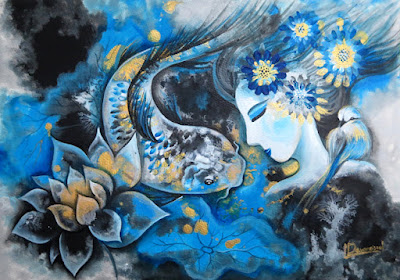April 25 (Lunar calendar: March 6), 2023 Tuesday | Dawnxisoul393art
Oscars 2022: CODA wins prize for best picture
CODA gives the world a chance to understand what real emotions are!
disability, affection, love, dream
Today we watched the slightly emotional, but actually very rich and wonderful 2022 94th Academy Award-winning Best Picture film "CODA (Children of the Deaf). “CODA” is the first film with a predominantly Deaf cast to win Best Picture, star Troy Kotsur is the first Deaf male actor to win an Oscar, Siân Heder wins Best Adapted Screenplay, and Apple becomes the first streaming service honored with Best Picture at the Academy Awards. CODA tells the story of Ruby, a girl who grows up in a deaf family and, after much struggles and growth, finally gets into the prestigious Berklee College of Music and reconciles with her family. Because she is the only "normal" person in her family, Ruby has to take on the job of "translating" between her family and the world, from keeping the whole family afloat to dealing with the friction between the family and the various people in their environment. Ruby is at the heart of the "workings" of this family's life. She experienced the exhaustion of life at a very young age. As the only hearing family member in a deaf family, Ruby is kind and dutiful, not only helping her father and brother fish to support the family but also being an important bridge between the family and the outside world.
Illustrated by dawnxisoul393
At critical moments Ruby always assumed the physical functions of her family's "mouth" and "ears". For Ruby's deaf family, her "normalcy" excluded her from the family, and she appeared to be a person who traveled between two worlds without being accepted by either side. The key to the drama was that this girl, who came from a family of deaf people, had a great musical talent and was a little genius with a beautiful voice. It was as if God had taken an entire family's vocal deficiencies and made up for them in this special child. In the treatment of sound, the subtle psychology of adolescence was embodied in the fierce confrontation between the sound world and the silent world, which was also the point of the film in the audio-visual treatment of form and theme. The family looked to Ruby for everything, but never paid attention to her, could not understand, and did not support her dream. The family became a burden on Ruby's dream pursuit, which also hindered her from integrating into the world of normal people.
When a normal person was in such a family, the "love" between the family members was also subtle and suffocating. When Ruby was born, her mother prayed that Ruby would be deaf and dumb. When the doctor told her that her daughter's hearing was normal, she was disappointed. Of course, Ruby's mother wanted her child to be healthy, but in the face of a healthy child, she lost the confidence to be a good mother. She feared that her bad self would fail Ruby and that Ruby would not be able to get close to herself because of this. Director Siân Heder cleverly brought out the unseen side of these special families and their deeper plight through characters like Ruby. Although "CODA" was adapted from the French film "The Bélier Family", the director had made a good localization of the whole text. When Ruby was ostracized outside, the family could become a haven to give a sense of belonging, which also became the source of security and fulfillment for the whole family.
When we were teenagers, we all had the embarrassment and frustration of not being able to find our own identity, just like Ruby. In our parents' eyes, we were always fledglings, but our restless hormones drove us to do stupid things to prove that we had grown up and had the ability to make our own choices in life. CODA visualized the subtle psychology of adolescence as a fierce confrontation between the audible and silent worlds. The extreme dramatic situation not only made the film unique among its peers, but the natural dual perspective narrative also allowed us to look at the relationship between the individual and the collective in a more dialectical and objective way. From Ruby's perspective, it was clear that her family had become a burden on her journey to her dreams, and had prevented her from integrating into the world of normal people. Ruby wants to escape the confines of her family and take control of her life, not spend the rest of her life as a translation machine. For her family, Ruby is the bridge between them and the outside world, and the key to being able to live in peace.
Illustrated by dawnxisoul393
Whenever Ruby showed signs of wanting to be independent, the role of parents would stand up and reminded her that her family was more important. From the perspective of the family, Ruby was not only a life-saving straw but also a mirror, which showed their powerlessness in the face of the world. Ruby finally could not bear the role of being the bridge between the family and the outside world. The film as a whole uses a very slow pace to unfold. Through Ruby can hear the sound of this advantage to filter out the difficulties in the family and the unfairness in the industry, but also let the audience in the first half of the film will deeply feel Ruby's hardship and heaviness. And these may be just the tip of the iceberg of the various encounters Ruby, a young girl, must face in life. Ruby's singing voice can make people hear a feeling of longing and reluctance, but also with a little longing and loneliness. The director really explains how to skillfully make a person's song come to life in front of the camera.
At the concert, the director used a minute-long silence to depict the helplessness of Ruby's family. They couldn't feel Ruby's singing. They could only judge Ruby's performance by observing other people's expressions. This minute made us instantly understand why the Ruby family didn't support Ruby's music dream. They couldn't know whether Ruby sang well or not, and they were afraid that she would be sad because of her failure. The emotional driver behind not supporting Ruby's musical dreams is the parental instinct to protect their children. Realizing individual values or safeguarding family rights and interests was not only a tangle of Ruby but also a practical problem in front of all of us. Ruby's mother was so concerned about ruby that she refused to loosen the thread in her hand and let Ruby fly away. However, holding the thread too tightly would make her feel deeply guilty. This motherly love tormented her. The more she tried to get close to Ruby, the further away she found Ruby from herself.
Illustrated by dawnxisoul393
The director wanted to improve the audience's experience of the deaf-mute group's performance in front of the film screen and decided to let the real deaf-mute play. It has to be said that the performance of deaf-mute actors has become a great bonus. Obviously, the director maximized the expressiveness of sign language this time, coupled with the seamless and meticulous cooperation of the actors, which contributed to several very brilliant clips in the film. It is believed that it is also the greatest humanistic significance of the film to enable deaf people to participate in the film creation. Emilia Jones as Ruby is somewhat rebellious and shows her individuality. Faced with the awakening of her self-awareness, she is not embarrassed in any way. Emilia Jones not only spent several months learning American sign language but also became a real family with three hearing-impaired actors during the shooting. The songs in the film were sung by her personally, and the audience was also lucky to see the sounds of nature beyond her acting skills.
There was a scene was the father and daughter sitting in the truck, the daughter wanted to let the father "see" her own singing, let him feel the throat vibration, the flow of emotion. Emilia Jones burst into tears and later shared the conversation with the director, who was also in tears. She was lucky to meet several deaf actors who taught her a lot. Marlee Matlin, who played the mother in the film, was 21 years old when she won the Best Actress Oscar at the 59th Academy Awards in 1987 for "Children of a Lesser God", which was both the first talkie in film history to star a hearing-impaired person and Marlee Matlin's first feature film. Through Marlee Matlin's gifted sign language performance, the world had the opportunity to know what real emotions were.
Original by dawnxisoul393,
Saturday, 16 Oct 2021













Comments
Post a Comment